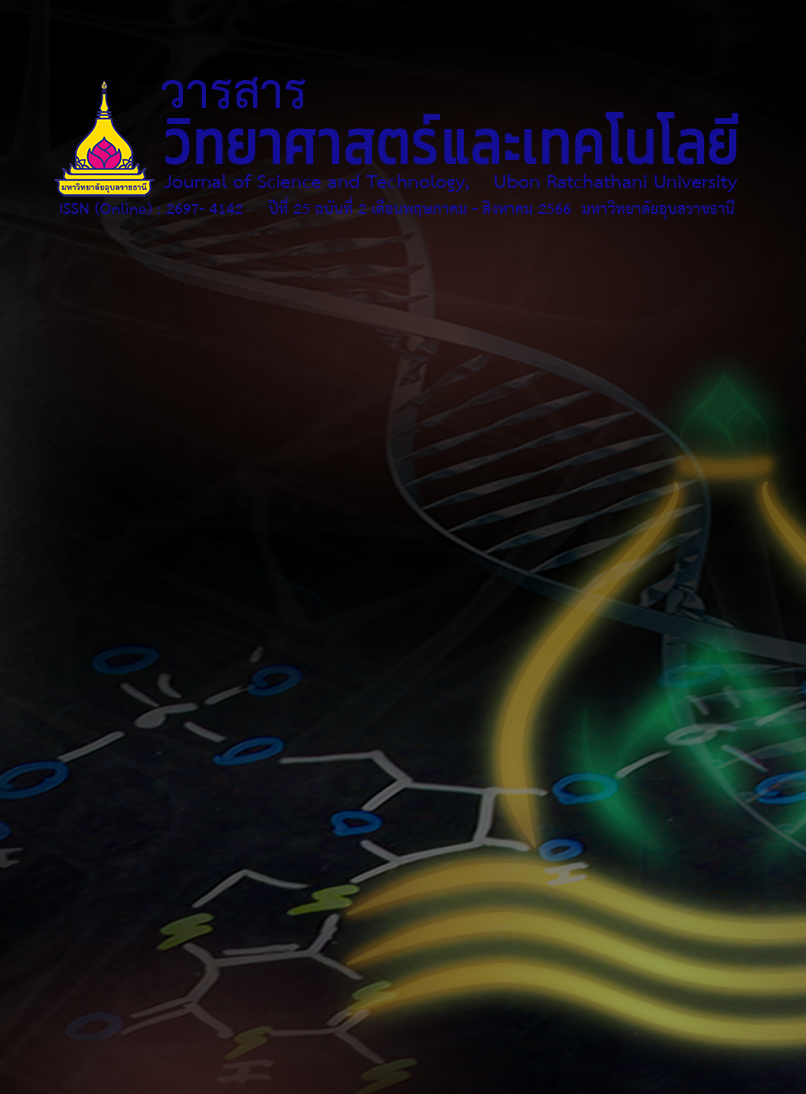การยับยั้ง Pythium aphanidermatum สาเหตุของโรคแง่งเน่าในขิงด้วยแบคทีเรียปฏิปักษ์
Main Article Content
บทคัดย่อ
โรคแง่งเน่าที่มีสาเหตุมาจากราก่อโรคส่งผลเสียต่อผลผลิตของขิง การใช้จุลินทรีย์เพื่อป้องกันและควบคุมโรคนี้เป็นวิธีที่น่าสนใจและเป็นมิตรต่อสิ่งแวดล้อม งานวิจัยนี้มีวัตถุประสงค์เพื่อแยกราสาเหตุโรคแง่งเน่าในขิง และเพื่อคัดเลือกแบคทีเรียที่มีประสิทธิภาพในการยับยั้งราที่ก่อโรครุนแรงที่สุดจากราที่แยกได้ ในการศึกษานี้แยกราสาเหตุโรคแง่งเน่าจากชิ้นส่วนของขิงที่เป็นโรคได้ 5 ไอโซเลต คือ ZP1, ZP2, ZP3, ZP4 และ ZP5 จากการทดสอบการก่อโรคในขิง พบว่าไอโซเลตที่ก่อโรคได้รุนแรงที่สุด คือ ไอโซเลต ZP4 เมื่อใช้วิธีการทางสัณฐานวิทยาและทางอณูพันธุศาสตร์สามารถจัดจำแนกราไอโซเลต ZP4 ได้เป็น Pythium aphanidermatum จากการคัดเลือกแบคทีเรียปฏิปักษ์จากดินรอบ ๆ ต้นขิง พบว่าจากแบคทีเรียจำนวน 73 ไอโซเลตที่คัดแยกมา มีเพียง 11 ไอโซเลตที่ยับยั้ง P. aphanidermatum ZP4 ด้วยวิธี dual culture technique โดยมี 5 ไอโซเลตที่ผลิตแบคเทอริโอซินในการยับยั้ง P. aphanidermatum ZP4 แบคทีเรียปฏิปักษ์ที่มีความสามารถในการยับยั้งราก่อโรค P. aphanidermatum ZP4 ได้สูงที่สุด คือ ไอโซเลต CP-8f และ CP-13e ซึ่งสามารถจัดจำแนกด้วยวิธี 16S rDNA sequence analysis ได้เป็น Bacillus velezensis และ Bacillus subtilis ตามลำดับ นอกจากนี้ยังพบว่าแบคทีเรียทั้งสองไอโซเลตนี้ผลิตเอนไซม์โปรติเอส แอลฟาอะไมเลส เซลลูเลส และเพคติเนส การศึกษานี้บ่งชี้ว่า Bacillus velezensis CP-8f และ Bacillus subtilis CP-13e มีศักยภาพที่จะใช้เป็นตัวควบคุมทางชีวภาพที่ปลอดภัย และเป็นมิตรต่อสิ่งแวดล้อมในการควบคุมราสาเหตุโรคแง่งเน่าในขิง
Article Details

อนุญาตภายใต้เงื่อนไข Creative Commons Attribution-NonCommercial-NoDerivatives 4.0 International License.
บทความที่ได้รับการตีพิมพ์เป็นลิขสิทธิ์ของ วารสารวิทยาศาสตร์และเทคโนโลยี มหาวิทยาลัยอุบลราชธานี
ข้อความที่ปรากฏในบทความแต่ละเรื่องในวารสารวิชาการเล่มนี้เป็นความคิดเห็นส่วนตัวของผู้เขียนแต่ละท่านไม่เกี่ยวข้องกับมหาวิทยาลัยอุบลราชธานี และคณาจารย์ท่านอื่นๆในมหาวิทยาลัยฯ แต่อย่างใด ความรับผิดชอบองค์ประกอบทั้งหมดของบทความแต่ละเรื่องเป็นของผู้เขียนแต่ละท่าน หากมีความผิดพลาดใดๆ ผู้เขียนแต่ละท่านจะรับผิดชอบบทความของตนเองแต่ผู้เดียว
เอกสารอ้างอิง
Mao, Q.Q. and et al. 2019. Bioactive compounds and bioactivities of ginger (Zingiber officinale Roscoe). Foods. 8(6): 185.
John, J., Mallikarjunaswamy, G.E. and Noushad, N. 2021. Probiotic rhizospheric Bacillus sp. from Zingiber officinale Rosc. Displays antifungal activity against soft rot pathogen Pythium sp. Current Plant Biology. 27(1): 100217.
Bureau of Agricultural Commodities Promotion and Management. 2021. Ginger, Annual Report 2021, Vegetable and Mushroom Promotion Group. http://www.agriman.doae. go.th/home/news/2564/26ginger.pdf. Accessed 9 September 2021. (in Thai).
Rai, M. and et al. 2018. Effective management of soft rot of ginger caused by Pythium spp. and Fusarium spp.: Emerging role of nanotechnology. Applied Microbiology and Biotechnology. 102(1): 6827-6839.
Bamon, M. and et al. 2018. In vitro efficacy of bacterial endophytes against Pythium sp. causing soft rot of ginger in Meghalaya. International Journal of Current Microbiology and Applied Sciences. 7(8): 367-374.
Behera, S. and et al. 2020. Pythium soft rot management in ginger (Zingiber officinale Roscoe) - A review. Current Journal of Applied Science and Technology. 39(35): 106-115.
Daly, P. and et al. 2022. Genome of Pythium myriotylum uncovers an extensive arsenal of virulence-related genes among the broad-host-range necrotrophic Pythium plant pathogens. Microbiology Spectrum. 10(4): 1-26.
Cui, W. and et al. 2019. Biocontrol of soft rot of Chinese cabbage using an endophytic bacterial strain. Frontiers in Microbiology. 10: 1471.
Goswami, D. and Syiem, M.B. 2021. Biocontrol of Pythium aphanidermatum causing soft rot in ginger with biosurfactant produced by a rhizospheric Bacillus species. Journal of Spices and Aromatic Crops. 30(1): 69-80.
Jinal, N.H. and Amaresan, N. 2020. Evaluation of biocontrol Bacillus species on plant growth promotion and systemic-induced resistant potential against bacterial and fungal wilt-causing pathogens. Archives of Microbiology. 202: 1785-1794.
Myo, E.M. and et al. 2019. Evaluation of Bacillus velezensis NKG-2 for bio-control activities against fungal diseases and potential plant growth promotion. Biological Control. 134: 23-31.
Xie, Z. and et al. 2021. Biocontrol efficacy of Bacillus siamensis LZ88 against brown spot disease of tobacco caused by Alternaria alternata. Biological Control. 154: 104508.
Tran, N.T. and et al. 2019. Phyllosticta capitalensis and P. paracapitalensis are endophytic fungi that show potential to inhibit pathogenic P. citricarpa on citrus. Australasian Plant Pathology. 48: 281-296.
Huzar-Novakowiski, J. and Dorrance. A.E. 2018. Genetic diversity and population structure of Pythium irregulare from soybean and corn production fields in Ohio. Plant Disease. 102: 1989-2000.
Kumar, S., Stecher, G. and Tamura, K. 2016. MEGA7: Molecular Evolutionary Genetics Analysis version 7.0 for bigger datasets. Molecular Biology and Evolution. 33(1): 1870-1874.
Chandramohan, M. and et al. 2019. Production, characterization and optimization of fibrinolytic protease from Bacillus pseudomycoides strain MA02 isolated from poultry slaughter house soils. Biocatalysis and Agricultural Biotechnology. 22: 101371.
Ahmed, S.A. and et al. 2019. Application of one-factor-at-a-time and statistical designs to enhance α-amylase production by a newly isolate Bacillus subtilis strain-MK1. Biocatalysis and Agricultural Biotechnology. 22: 101397.
Ma, L. and et al. 2020. Screening of cellulolytic bacteria from rotten wood of Qinling (China) for biomass degradation and cloning of cellulases from Bacillus methylotrophicus. BMC Biotechnology. 20: 2.
Guo, F. and et al. 2019. Optimizing culture conditions by statistical approach to enhance production of pectinase from Bacillus sp. Y1. BioMed Research International. 2019: 8146948.
Kim, O. and et al. 2012. Introducing EzTaxon-e: a prokaryotic 16S rRNA gene sequence database with phylotypes that represent uncultured species. International Journal of Systematic and Evolutionary Microbiology. 62: 716-721.
Fira, D. and et al. 2018. Biological control of plant pathogens by Bacillus species. Journal of Biotechnology. 285: 44-55.


